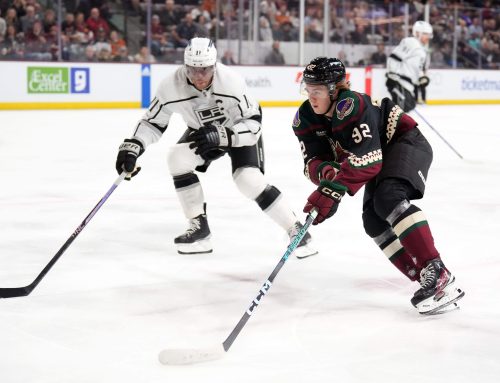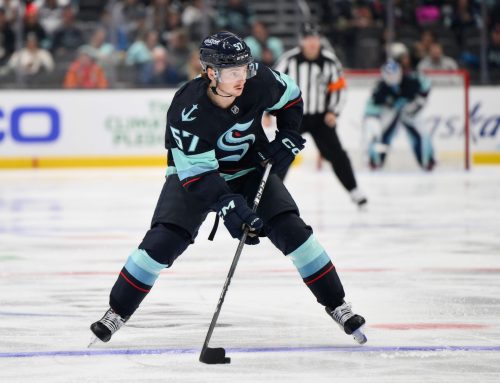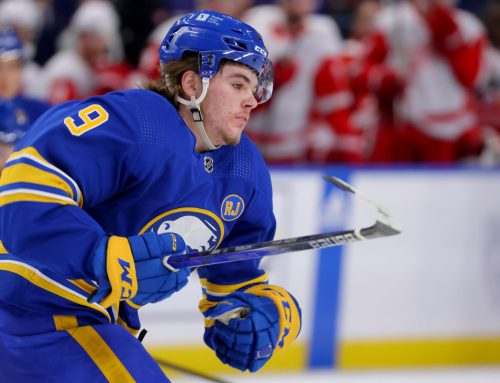The Journey: Nichushkin and The Post-Hype Big Men
Ben Gehrels
2022-06-18
Welcome back to The Journey, where we follow hockey prospects and their paths to the NHL, providing fantasy predictions and analysis along the way.
The scouting team over at Dobber Prospects just released their final rankings for the 2022 NHL draft. Check it out! They ranked the relentless big man Juraj Slafkovsky (6-4, 218 lbs) at second overall. The dramatic rise of Slafkovsky on boards all across the industry, plus the critical role that fellow big man Valeri Nichushkin (6-4, 210 lbs) is playing for the Colorado Avalanche in their postseason run, has inspired the focus for this week's Journey: using Dobber's concept of the Breakout Threshold (BT), we'll look around the league for other post-hype big men like Nichushkin who seem to be putting everything together and attempt to project their ultimate upside.
From a previous Journey article, here’s part of Dobber’s BT definition: “Average-sized forwards (between 5-10 and 6-2, or between 171 and 214 pounds) need 200 NHL regular season games to figure it out. At that point, they should show what they will be when fully developed.” This isn’t the same as peaking, more like the beginning of a player’s prime production years.
Even more importantly for this week's article, players that are smaller or bigger than those height/weight guidelines tend to take twice as long, 400 games, to hit their BT. From examining data sets over time, Dobber has found this rule to be about 80% accurate. While not perfect, it can be extremely useful at indicating when to buy low on players that others have given up on.
Back to the Slafkovsky-Nichushkin comparison for a moment. Even if Slafkovsky ends up going second overall in the real draft, that doesn't necessarily mean fantasy owners should be jumping on him at that slot. Other top prospects like Shane Wright and Logan Cooley, both average-sized, could easily end up hitting their upside over two and a half seasons earlier than Slafkovsky. That's a loooooooong time in fantasy.
Pre-draft, players have a sexy sheen to them in fantasy. We hear these names repeated over and over, wonder who our favourite team is going to come away with, and speculate endlessly about the magic word, "upside." What is their ceiling going to be? Which current NHL players are they comparable to? Peak Slafkovsky, for instance, could turn into a Mikko Rantanen type—an elite, point-per-game all-star.
That sheen wears off incredibly quickly after the draft in fantasy, however. Just look at Rangers prospects like Alexis Lafreniere (1st overall, 2020) and Kaapo Kakko (2nd overall, 2019). Neither player has taken the league by storm yet 150ish games into their careers, and the hockey media machine has pumped out article after article about whether or not these two are busts. Their value in fantasy right now is surely lower than it was just before or after their respective drafts.
Nichushkin is another telling example. He was drafted tenth overall back in 2013 by Dallas and there was an incredible amount of hype around the young, rangy Russian. He split time that year between the three Russian leagues (MHL, VHL, KHL) and posted decent numbers. When he crossed the pond in 2013-14 and put up 34 points in 79 games for Dallas as a rookie, poolies were ecstatic. Nichushkin was the next big thing.
But then things seemed to fall apart. He saw some AHL time and posted 30 points over his next 87 NHL games before heading back to Russia to play in the KHL. After two KHL seasons, he rejoined the Stars for 57 games and put up a lowly 10 points. It seemed pretty clear to everyone at this point that he was now a depth performer at best. Another Yakupov. As an Avalanche fan, I was intrigued when Colorado acquired him the following year to play in their middle six. He seemed like a decent speculative add given his former pedigree, and he immediately stood out on the ice for his mobility, physicality, and defensive awareness. Even still, he posted only 48 points in his first 120 games with the Avalanche.
Guess what happened in 2021-22? He played his 400th game and broke out in a serious way with a 70-point pace. He's currently sitting at 405 regular season games for his career, a mark that is slightly higher if you account for this playoff action. Looking back on his career trajectory, 70 points is the kind of production everyone hoped and even thought he was capable of back in 2013. But those expectations only stuck around for maybe a season and a half. For most of the past decade, Nichushkin was considered a bust.
The lesson here is that poolies need to pay close attention to where they draft exceptionally sized players like Slafkovsky. An interesting strategy would be letting someone else take the big Slovakian, wait patiently for them to get frustrated when he hasn't broken out for two or three seasons, trade for him then when his value is lower, and then reap the benefits when he hits his 400-game Breakout Threshold. The thing about 400 games is that players definitely do not feel like prospects anymore by the time they reach it. But when building your team in keeper and dynasty formats, it's important to consider players currently in the NHL through that same lens.
Let's take a look now at some other interesting players who are exceptionally sized (bigger than 6-2, 214 lbs) and approaching their 400-game Breakout Thresholds.
Anthony Mantha (353 GP) & Patrik Laine (407 GP)
First, a couple star-level talents. Both of these players have already "broken out" to some degree, so it is a bit of a grey area deciding whether or not the 400-game BT actually applies to them. Mantha hit a 72-point pace in 2018-19 but has never exceeded 50 points in a season due to injuries. Laine, of course, scored 44 goals and 70 points in his second year with Winnipeg and has two other point-per-game seasons under his belt but has also struggled with inconsistency, posting two years of close to half-a-point per game.
Both Mantha and Laine are 6-5, however, and are currently right around their projected BTs—Laine hit it right at the end of 2021-22 like Nichushkin, and Mantha will cross 400 near the conclusion of 2022-23 if he can finally stay healthy. What can poolies expect from these players moving forward? It wouldn't be surprising to see the 24-year-old Laine finally join and remain in the ranks of the NHL's elite forwards for the next decade or so. He is still one of the purest goal scorers in the league in terms of his shot and puck skills.
Plus, Laine has become even more dangerous as a scorer because he has improved his playmaking over the past few years to the point that his assists now outnumber his goals. His development as a playmaking threat should create more room for him to post even gaudier goal totals now that opposing defences have to respect his passing skill. He's no longer a one-dimensional shotgun waiting to blast pucks from the top of the circle. His draft pedigree and solid performance in 2021-22 has likely made him expensive to acquire in fantasy but this offseason might be the last chance to get a hold of him for a reasonable price—especially if you can successfully point to his past inconsistency.
Mantha (27 years old) is harder to project, but his 50-point pace over 37 games with Washington last year is likely his floor moving forward. Injuries cloud everything, and Mantha is Band-Aid Boy Certified, so we can expect him to miss 10-20 games a year, kind of like Evgeni Malkin. Adjust your projections accordingly but I still believe his ceiling is in the 70s. His career arc reminds me a bit of Matt Dumba's strange pattern: Mantha saw a steady point-per-game progression for five straight seasons (0.3 → 0.6 → 0.6 → 0.72 → 0.88) before he was traded from Detroit to Washington in 2020-21 after dealing with injuries. His point pace dropped to 0.52 that year and then climbed slowly back to 0.62 in 2021-22. Like Dumba, look for Mantha to push his ppg pace another 0.1 this coming year into 0.7 ppg territory—that's about 60 points—with close to three shots and a hit-and-a-half per game. Assuming he stays healthy, he'll hit his BT just past the halfway mark in 2022-23 and could threaten for 70 points the following year if everything breaks right.
Pavel Zacha (386 GP), Lawson Crouse (346 GP) Yanni Gourde (384 GP)
In this mid-tier group, we have two bigger players in Zacha (6-3, 210 lbs) and Crouse (6-4, 220 lbs) and a smaller player in Gourde (5-9, 172 lbs). While none of these guys project to become stars, each can provide excellent value for your fantasy squad—especially if they happen to fall into the 80% of players accurately described by the BT theory.
Like Mantha, Zacha (25 years old) demonstrated a steady ppg progression over his first five seasons (0.34 → 0.36 → 0.41 → 0.49 → 0.70) before slipping back to a 0.51 pace in 2021-22. While the Devils are a team on the rise, led by their two former #1 overall centers in Nico Hischier (2017) and Jack Hughes (2019) and boosted by elite prospects like Alexander Holtz, Dawson Mercer, and Ty Smith, it's not clear whether or not Zacha will stand to benefit from his team's progression. Barring an injury to Hughes or Hischier, Zacha is firmly slotted into the third-line C role and will likely miss out on exposure to the team's rising stars. Hischier missed all but 21 games in 2020-21, which perhaps explains Zacha's rise that year into nearly 60-point territory. When Hischier returned the following year, Zacha's pace declined back into the 40s.
These past few years have projected a realistic floor of 40 points and a ceiling of 60 points for Zacha. In multi-cat formats, he also adds value with a couple shots, a hit, and a few face-offs wins per game—for a modest cap hit of $2.25 million. He is a Restricted Free Agent (RFA) this offseason, so his next contract should provide more context for what we can expect from him moving forward, but he will likely get a slight raise and flirt with 50 points as he hits his BT 14 games into 2022-23.
Crouse, 24, is still almost a full season away from his BT, but his 43-point pace in 2021-22 was by far his career high. He has built a reputation as a player who will give you a couple shots and three hits per game plus maybe 25 points a year. That was already valuable in deeper formats, but if Crouse can maintain his 40-point pace or even bump it slightly into the 50s, he'll become one of these fantasy hockey unicorns (Tom Wilson, Tanner Jeannot) that poolies love to stick in their UTIL slots to significantly boost their category coverage. He too is an RFA this offseason. Like Nichushkin, Crouse was a high first-round draft pick (11th overall in 2015) and is a player who feels like he has been around forever—as in, not at all a prospect anymore. Watch him carefully this year, though: he was never considered a premier offensive talent, but he is a speedy player with a good shot who could become incredibly valuable in fantasy under the right circumstances.
Although Gourde, 30, went from the best (Tampa) to the worst (Seattle) team in the league this past year, he posted an identical pace of 53 points in both 2020-21 and 2021-22. Adding to the difficulty of his projection is the fact that he didn't break into the NHL until age 24-25, so he has only played six seasons in the league even though he's already 30 years old. His best output to date was 64 points in 2017-18. He will hit his BT as a smaller player about 16 games into the upcoming campaign, and if Seattle takes a step forward with Matty Beniers joining the team and the group as a whole settling in a bit more, perhaps we see Gourde push 60 points. No one on the Kraken exceeded 50 points in 2021-22, however, and this looks like a team that may live in the bottom half of the league for the next while after badly mishandling their entry draft last year. Realistically, expect 50 points from Gourde, along with a couple shots, a hit, and five or six faceoff wins per game in 2022-23. Those are useful numbers in the right formats.
As a final insight, watch the development of Kings mega-prospect Quinton Byfield from a distance. His value is still incredibly high in fantasy right now, but he is a huge player (6-4, 215 lbs) and it could easily be another four and a half seasons before we see his true upside. As with Slafkovsky and the rest, that is an incredibly long time in fantasy. If he posts a few 40-50-point seasons over the next few years (just look at Nathan MacKinnon), his owner in your league may begin to lower their estimation of his upside. That will be the time to pounce.
Thanks for reading! Follow me on Twitter @beegare for more prospect content and fantasy hockey analysis.





 WSH
WSH NYR
NYR NSH
NSH VAN
VAN COL
COL WPG
WPG L.A
L.A EDM
EDM CHI
CHI T.B
T.B CAR
CAR NYI
NYI PHI
PHI
